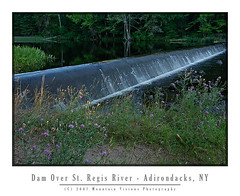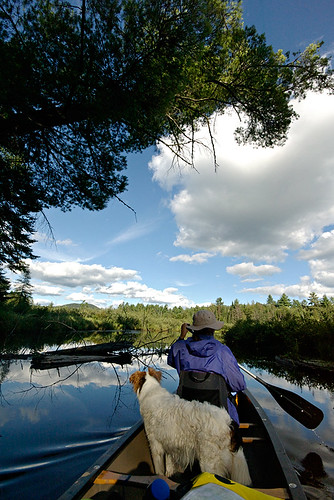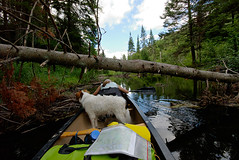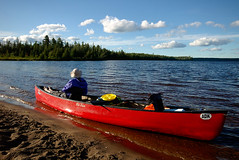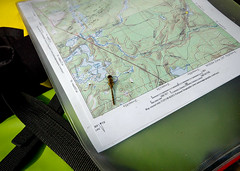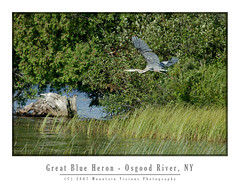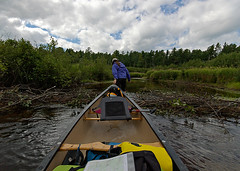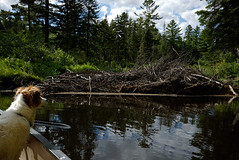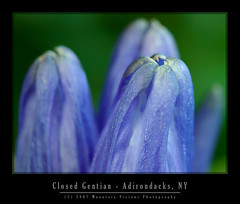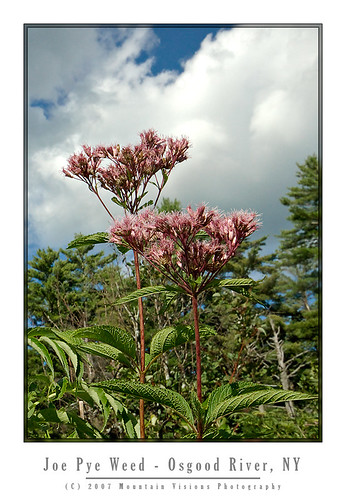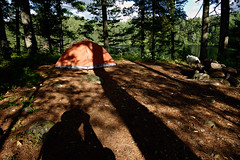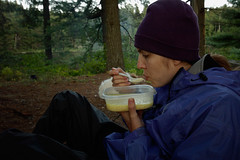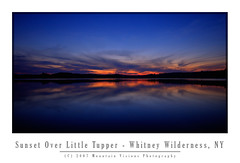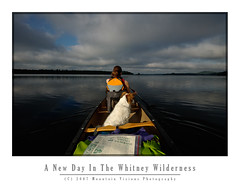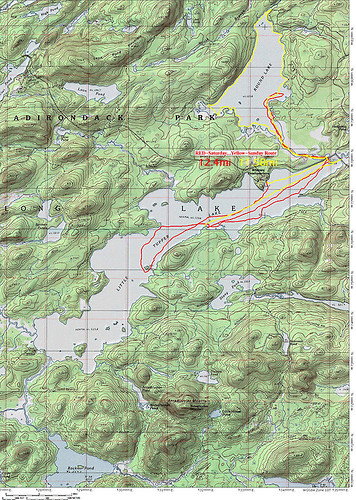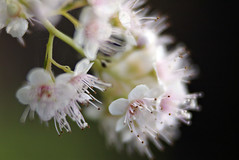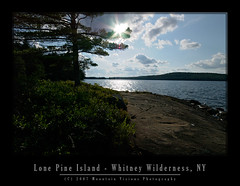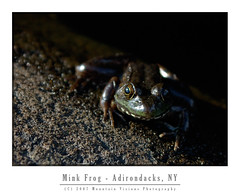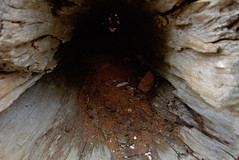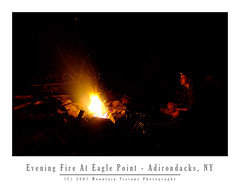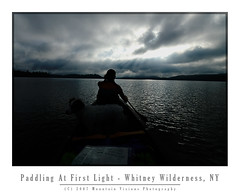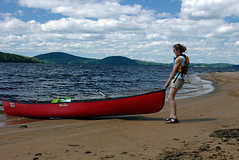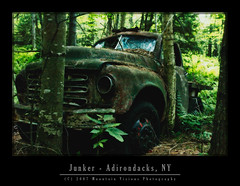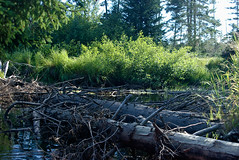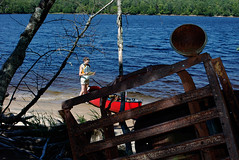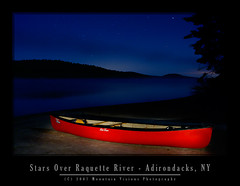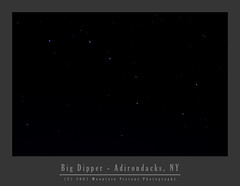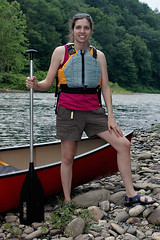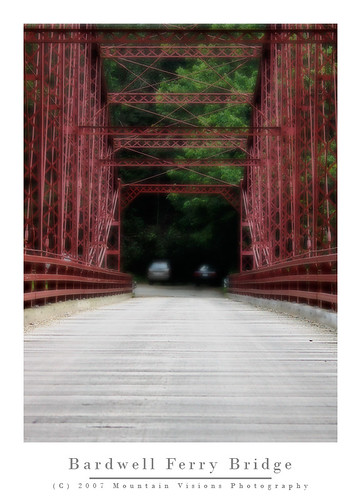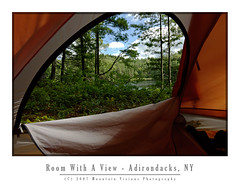 The Osgood River is the purest sense of a dichotomy. The scenery, wildlife and feel of the paddling would make you believe you were deep in the heart of a boreal wilderness. Then the wind dies down, and you hear Rt. 30 with one of the longest straight strectches of pavement in the Blue Line, busling with speeding traffic from Paul Smiths, Tupper Lake and Saranac Lake to Malone outside the Blue Line.
The Osgood River is the purest sense of a dichotomy. The scenery, wildlife and feel of the paddling would make you believe you were deep in the heart of a boreal wilderness. Then the wind dies down, and you hear Rt. 30 with one of the longest straight strectches of pavement in the Blue Line, busling with speeding traffic from Paul Smiths, Tupper Lake and Saranac Lake to Malone outside the Blue Line.
Buried with work, we got a late start Friday night. Pulled into the put-in at 2am to the sound of rain drops on the roof. No chance to set up my tent, and too tired to, we slept soundly, if not coldly, in the car.
I woke up Saturday at 6am to continued rain, fog and 40F temps. Back to sleep till 10am when it when it stopped raining, although still looked cold and dreary.
Aim wasn't too happy about putting in. She is the definition of a fair weather paddler. 75F and sunny, or turn the car around and head home. Unfortunately, in the Daks, rain and occasional barely 60F summer days are part of the game, otherwise, expect to paddle once or twice a summer at most.
Really it wasn't the rain, cloud cover or damp coldness that was disheartening, rather, the fact that you couldn't escape the bitter wind blowing from the north. It had the end of October crisp chill to it.
After we unloaded an older couple pulled up with a car top canoe. They came down to the water bundled up, looked at us shivering and shook their heads. "We're headed home, too cold out there for us."
Aim gave me a look when they said that like, "can we please go home!"
Not a chance. I told her this is good practice for October paddling and to suck it up.
Caney was already in the water swimming, he approved of the St Regis, and said this looked like a good river to paddle.
Admittedly it was darn cold. I was wearing my neoprene socks under my sandals, I had on my goretex shell, a t-shirt, and a long sleeve base layer under my PFD. Typically I don't wear this much even for October paddling and I was still chilly.
I stayed chilled all day, and was convinced my thermometer didn't work. 61F? I've never been cold unless I was wet in temps that mild. Yet, even after the sun decided to do it's thing, I was still never really warmed up all day.
Eventually we got on the water and the cool temps didn't seem so awful as we paddled upstream on the St Regis River towards Meacham Lake. Our destination was the the mouth of the Osgood River at the southern shore of Meacham Lake.
From the descriptions the Osgood looked like one of those 30 foot wide meandering rivers with a crooked course and beaver dams that I love so much. Even more so it looked like a place that didn't see much traffic. Really there was nothing super appealing in the descriptions for the average paddler. No great views, no amazing campsites, no waterfalls, just a nice meandering river surrounded by a boreal forest.
Most the the Adirondacks, which are part of the Candian Shield and not the Appalachians like the rest of the Northeastern US, straddle a transition zone of mountains and lakes that is unique toeastern North America. The region lies in the transition zone betweenthe eastern deciduous and boreal forest ecosystems. The Osgood is actually above the transition zone and almost entirely boreal. The fully boreal biome of the Adirondacks below 4000ft is rather small and isolated. Much of the public holdings are recent, and part of the Champion Lands purchases in the last few years. Paddling the Osgood, like the Jordan, you immediately see the difference in the nature of the forest compared to most other places within the Blue Line.
I'm pretty social out in the wilds but at times I like the peace of knowing I'm somewhat alone, even if only in theory. Sometimes it's nice to be the only boat on a particular body of water. Looking at the maps the Osgood looked like the ticket, and of course the weather meant there would be few day paddlers coming from Meacham Lake as well.
Well, the Osgood was exactly what I'd envisioned; other than the sound of the road.
When viewing the river corridor on a map, the west bank is within 3/4-1.5 miles of the river but not closer until below Barnum Pond. Yet, you could hear trucks, and motorcylces for that 3/4 mile minimum distance whenever the blustery winds died down. Now to the east the river is not bordered by a paved road for many many miles. Actually, it's all forest preserve land to the rivers east.
Perhaps on a less beautiful flow this would have been enough to spoil the paddle but the Osgood was simply too beautiful with flower covered boreal shorelines, and spectacular wildlife.
We saw at least 6 great blue heron, 1 egret, deer, a baby beaver on a giant beaver dam/lodge, countless whiskey jacks (gray jays), wood ducks, mallard ducks, and many more species of birds than I know the names of. This is all despite a 10am start Saturday and a late start Sunday as well.
While beaver activity in this area could be seen, there were very few dams. The fact that the boreal forest lining the shores was mostly conifers made it tough for the beavers to slow us down. Beavers prefer hardwoods and with the relative lack of options quickly eat themselves out of house and home before that can create too much trouble for paddlers.
Despite the lack of hardwoods, we saw one of the most innovative beaver dams I've ever seen. It was a dam and lodge built into one. As we approached it on the paddle out Sunday we saw a small baby beaver walking around on top and eventually go down into the lodge. Mom and dad must have been off looking for hardwoods to to repairs on the breached river left edge of the dam.
The flora on this river refused to be second fiddle to the abundant wildlife. I'd venture to say we saw nearly every type of equatic plant native to the northern Adirondacks. From carnivorous pitcher plants, to candy apple red cardinal flowers, to joe pye weed, to pickerelweed , water lily, water hemlock, and countless others.
Saturday we camped high on a narrow esker that separated the river from a pond. Our campsite, wholey exposed to the north wind, was a bit chilly but made for excellent camping. I commented to Aim that it felt like we were on a Adirondack alpine summit. The ferocity and coldness of the wind had that unmistakable alpine feel. The winds, according to the weather station in Saranac Lake, were gusting to 29mph.
Despite the previous nights rain we got a fire going faster than I've ever seen. The dry wind coming from the north dried out every bit of wood and fed the fire with enough air to have it blazing in minutes. Rarely have I seen a fire take off with such little effort.
The wind eventually died down enough that it was just a slight breeze at times. It actually felt warmer as we ate dinner despite the fact that the temperature dropped from 61F when we got to camp to 55F while we were eating.
Sunday after sleeping in late, we had a late breakfast including fresh blueberries picked from around the camp. Such a nice addition to my otherwise bland cereal.
Despite the less than perfect summer weather - it was perfect October weather, and our 5th rainless weekend in a row - the Osgood was truly a spectular river. Most of the shoreline is within the forest preserve and on the stretch we paddled we only saw a few posted signs, and 2 actual private residences. The rest of the river and shoreline was superbly wild in nature. With a set of earplugs, I'd paddle the Osgood over the Oswegatchie, an Adirondack benchmark for scenic wild rivers, any day of the week and twice on Sunday.
technorati tags:ADK, Adirondacks, paddling, paddle, wilderness, photography, birding, wildlife, Pentax, New York, DEC, camping, Osgood River, St Regis, canoe, kayak, Daks, Meacham Lake, Rt 30, Saranac, Tupper, esker, boreal, forest, Forest Preserve, mountain, dam, Barnum, Sigma, heron, beaver, river, flowers, flora, Joe Pye Weed, Closed Gentian, fire
Blogged with Flock








